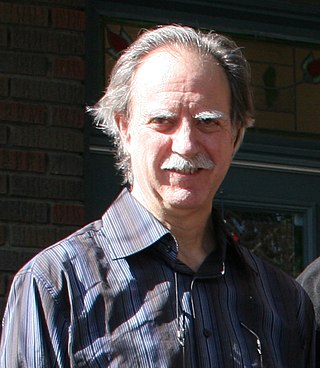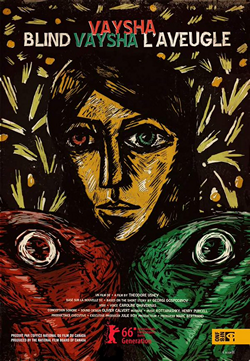
The National Film Board of Canada is Canada's public film and digital media producer and distributor. An agency of the Government of Canada, the NFB produces and distributes documentary films, animation, web documentaries, and alternative dramas. In total, the NFB has produced over 13,000 productions since its inception, which have won over 5,000 awards. The NFB reports to the Parliament of Canada through the Minister of Canadian Heritage. It has bilingual production programs and branches in English and French, including multicultural-related documentaries.

Drawn-on-film animation, also known as direct animation or animation without camera, is an animation technique where footage is produced by creating the images directly on film stock, as opposed to any other form of animation where the images or objects are photographed frame by frame with an animation camera.
Caroline Leaf is a Canadian-American filmmaker, animator, director, tutor and artist. She has produced numerous short animated films and her work has been recognized worldwide. She is best known as one of the pioneering filmmakers at the National Film Board of Canada (NFB). She worked at the NFB from 1972 to 1991. During that time, she created the sand animation and paint-on-glass animation techniques. She also tried new hands-on techniques with 70mm IMAX film. Her work is often representational of Canadian culture and is narrative based. Leaf now lives in London UK and is a tutor at The National Film and Television School. She maintains a studio in London working in oils and on paper and does landscape drawing with iPad.

Sand animation is the manipulation of sand to create animation. In performance art an artist creates a series of images using sand, a process which is achieved by applying sand to a surface and then rendering images by drawing lines and figures in the sand with one's hands. A sand animation performer will often use the aid of an overhead projector or lightbox. To make an animated film, sand is moved on a backlit or frontlit piece of glass to create each frame.
George Garnett Dunning (1920–1979) was a Canadian filmmaker and animator. He is best known for producing and directing the 1968 film Yellow Submarine.
Ishu Patel is an animation film director/producer and educator. During his twenty-five years at the National Film Board of Canada he developed animation techniques and styles to support his themes and vision. Since then he has produced animated spots for television and has been teaching internationally.

Normand Roger is a Canadian composer, sound editor and sound designer. He is particularly known for his work as a composer of soundtracks for animated films, having composed more than 200 such works since 1970. He has also worked on the creation of music for documentaries, feature films, television dramas, children's series, commercials, and new technologies with 3D and virtual reality. He is the composer of many original soundtracks for Frédéric Back, Paul Driessen, Michaël Dudok de Wit, Caroline Leaf and Aleksandr Petrov. Thirteen of his works have been nominated for Academy Awards, of which six have won. He also notably wrote the theme for the PBS's Mystery!. Roger lectures throughout the world on music and sound for animation.

Walking is a 1968 Canadian animated short film directed and produced by Ryan Larkin for the National Film Board of Canada, composed of animated vignettes of how different people walk.

Gerald Potterton was a Canadian director, animator, producer and writer. He is best known for directing the cult classic Heavy Metal and for his animation work on Yellow Submarine.

Hunger/La Faim is a 1973/1974 animated short film produced by the National Film Board of Canada. It was directed by Peter Foldes and is one of the first computer animation films. The story, told without words, is a morality tale about greed and gluttony in contemporary society.
The Street is a 1976 animated short film created by Caroline Leaf for the National Film Board of Canada.
The Sand Castle is a 1977 stop motion animated short created by Co Hoedeman for the National Film Board of Canada. It won the Academy Award for Best Animated Short Film at the 50th Academy Awards.

Janet Laurie Perlman is a Canadian animator and children's book author and illustrator whose work includes the short film The Tender Tale of Cinderella Penguin, which was nominated for an Academy Award for Best Animated Short Film at the 54th Academy Awards and received a Parents' Choice Award. Her 13 short films have received 60 awards to date. She was married to the late animation producer Derek Lamb. After working with Lamb at the National Film Board of Canada in the 1980s, they formed their own production company, Lamb-Perlman Productions. She is currently a partner in Hulascope Studio, based in Montreal. Perlman has produced animation segments for Sesame Street and NOVA. Working with Lamb, she produced title sequences for the PBS series Mystery!, based on the artwork of Edward Gorey, and was one of the animators for R. O. Blechman's adaptation of The Soldier's Tale for PBS's Great Performances. She has also taught animation at Harvard University, the Rhode Island School of Design and Concordia University. She and Lamb were divorced but remained creative and business partners until his death in 2005.
Wendy Tilby and Amanda Forbis are a Canadian animation duo. On January 24, 2012, they received their second Oscar nomination, for the National Film Board of Canada (NFB) animated short film, Wild Life (2011). With their latest film, The Flying Sailor, they received several nominations and awards, including for the Best Canadian Film at the Ottawa International Animation Festival, and on January 24, 2023, they received a nomination for the 95th Academy Awards under the category Best Animated Short Film.
The Boy Who Saw the Iceberg is a 2000 animated short by Paul Driessen, which uses a split screen to portray the real life and imaginary life of a young boy. A film without words, the 8 minute and 49 second National Film Board of Canada short is a retelling of the 1912 sinking of the Titanic through the eyes and active imagination of a young boy.
Robert Verrall is a Canadian animator, director and film producer who worked for the National Film Board of Canada (NFB) from 1945 to 1987. Over the course of his career, his films garnered a BAFTA Award, prizes at the Cannes Film Festival and Venice Film Festival, and six Academy Award nominations.

Blind Vaysha is a 2016 animated short by Theodore Ushev, produced by Marc Bertrand for the National Film Board of Canada, with the participation of ARTE France. Based on a story by Georgi Gospodinov, the film tells the story of a girl who sees the past out of her left eye and the future from her right—and so is unable to live in the present. Montreal actress Caroline Dhavernas performed the narration for the film, in both its French and English language versions. The film incorporates music from Bulgarian musician and composer Kottarashky and is his and Ushev's fourth collaboration.
The Owl Who Married a Goose: An Eskimo Legend is a 1974 Canadian animated short from Caroline Leaf, produced by the National Film Board of Canada and the Canadian Department of Indian and Northern Affairs.
Interview is a 1979 Canadian short live-action animated documentary film directed by Caroline Leaf and Veronika Soul, produced by David Verrall. The film is a record of a working day in the lives of two women filmmakers, sometimes described as "an autobiographical collaboration", though both filmmakers are discussing the other woman. The film is also seen as a study of female friendship, the women relating their perceptions of each other through their respective animation techniques, "each creating a visual portrait of the other based on characteristic gestures and impressions."
Jacques Giraldeau (1927-2015) was a Canadian documentary filmmaker from Quebec. He spent most of his career at the National Film Board of Canada and became known primarily for his films about the history of Quebec as seen through the eyes of its artists. He had a fondness for the avant-garde and many of his films are considered to be experimental.










